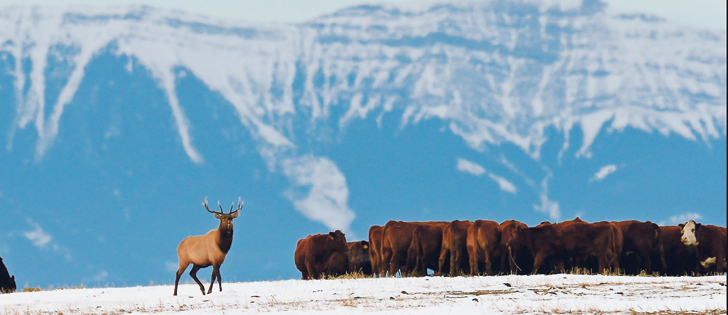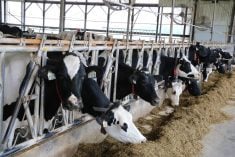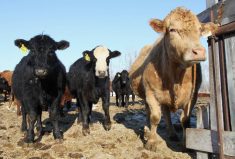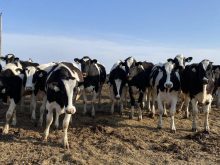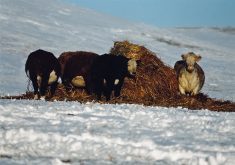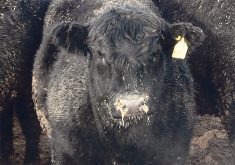Current Alberta case has required considerable detective work to find all infected animals and determine disease origin
HANNA, Alta. — Canadian cattle have been tuberculosis-free since 1985, which has reduced the level of understanding of the disease among producers.
However, the discovery of a small number of cases on a southeastern Alberta ranch last fall sparked renewed interest in the disease.
The cases resulted in the quarantine of 58 operations and condemnation of 10,000 cattle.
It is a complex case because of the size of the herds and the mixing together in community pastures, Randy Wiens of the Canadian Food Inspection Agency said at a producer meeting in Hanna Jan. 25.
Read Also

Beef check-off collection system aligns across the country
A single and aligned check-off collection system based on where producers live makes the system equal said Chad Ross, Saskatchewan Cattle Association chair.
“It is a jumble to sort out.”
The nature of the disease is complex because it can take years to emerge, said veterinarian Sylvia Checkley of the University of Calgary’s faculty of veterinary medicine. As well, correctly identifying the bacteria takes time, she added.
A rod-shaped bacterium called mycobacterium bovis is responsible. It causes weakness, loss of appetite, low-grade fever, moist cough and possibly enlarged draining lymph nodes or diarrhea or constipation if the gut is affected.
Cheese-like substances called tubercles can form in lymph nodes of the head, chest, liver, lung, spleen and surface of the body cavity. They can calcify and become gritty and hard.
It can infect other species, including people, although that risk is very low, said Checkley.
The bacteria live in moist, cold conditions in manure or soil but are susceptible to sunlight, drying and extreme cold.
“It is difficult to determine how long it might survive,” she said.
The bacteria might live for up to a year under the right circumstances.
“TB can be treated with antimicrobials, but it can be fatal in people if left untreated,” she said.
Canada started an eradication program in its cattle herd in 1923. Canada, Australia, Switzerland and the Scandinavian countries are among those considered TB free. Eradication programs are underway in other regions, which include wildlife surveillance.
Cattle spread the disease through respiratory excretions, milk, urine, semen and vaginal secretions. Animals with runny noses can touch others and spread it. It could end up in feed or water.
Not all animals may shed the bacteria, and symptoms may be undetected until the disease is well advanced.
In countries where tuberculosis is found, it is usually diagnosed at a slaughter plant where lesions are spotted on internal organs.
The current case in Alberta involves considerable detective work by CFIA staff to find all the animals that might be infected as well as figure out where it came from.
Genetic tests linked it to a strain found in Mexico in 1995, but Wiens said this does not mean it came from Mexico.
The current investigation uses different diagnostic tests to detect and verify the disease.
The caudal fold test has been used throughout the world for the last 100 years. Tuberculin is injected into the folds around the tail head. Swelling within 24 to 72 hours at the site indicates a reaction, but it does not necessarily mean the animal has the disease.
Blood is also drawn at the same time to conduct the ELISA (enzyme linked immunosorbent assay) to create higher confidence in the specificity of the test among high risk cattle, said Wiens.
The caudal fold test was run on lower risk herds and if there is a reactor, a blood analysis called the bovigam test checks immune response in cells.
Cultures are also grown in laboratories to confirm the diagnosis, but results take about 12 weeks.
The next step for infected farms is cleaning and disinfection.
The bacteria are susceptible to moist heat of 121 C for a minimum of 15 minutes.
Corrals must be scraped out to remove manure, and facilities must be disinfected. No one will have pets or horses euthanized.
The infected farm can restock after 45 days following clean-up, and the herd will be retested after six months. Another round of tests are run 18 months later. Any reactors will be killed to see if they are positive or negative.
About 10,000 animals were condemned in the recent Alberta case. Most of the adult animals are gone, and a facility has been contracted to destroy calves. The plant accepts them three days a week and about 100 are slaughtered each day. Those carcasses will be rendered.
About $6 million in CFIA compensation has been paid based on an agency formula. It offers $4,500 maximum for commercial cattle and $10,000 for registered cattle, but the current market is far below that.
Lines of inquiry will continue to find cattle that came into the herd and determine where they came from. Those herds could be tested, which means the quarantine could expand beyond the Brooks-Jenner region, said Wiens.
“If we don’t get any more confirmed positives, you are not going to see that net cast much wider. The only thing will be the trace in animals,” he said.
Of the six confirmed positive cases at the Jenner site, one came from another herd that was tested and ruled disease free.
Tracing has been a challenge. The search has relied on Canadian Cattle Identification Agency ear tags, brands and producer records. The challenge occurred when movement was not recorded.
Wildlife has been suspected as the source, but no evidence indicates elk are responsible. However, the CFIA will be talking with Alberta Environment in first week of February about future surveillance of elk in that region.
“Lots of people think there is a connection and are very suspicious of the elk,” Wiens said.
“They continue to be on our radar, but we are waiting for more evidence to support the suspicion,” he said.




